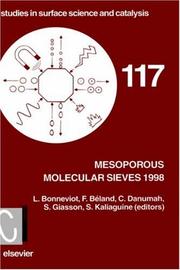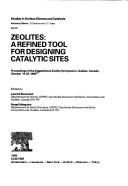| Listing 1 - 4 of 4 |
Sort by
|

ISBN: 9780444828262 0444828265 9780080536248 0080536247 9786611058517 1281058513 Year: 1998 Publisher: Amsterdam New York Elsevier
Abstract | Keywords | Export | Availability | Bookmark
 Loading...
Loading...Choose an application
- Reference Manager
- EndNote
- RefWorks (Direct export to RefWorks)
The original properties of mesoporous molecular sieves are so unique that the design of most existing catalysts could be reconsidered. It might indeed be of interest to introduce MMS either as a support or as the active phase, merely on the basis of their high surface areas, narrow pore size distribution and flexibility in composition. The recent literature provides examples of MMS based catalysts of many types such as acid-base solids, supported metals and supported oxides, mixed oxides, anchored complexes and clusters, grafted organic functional groups and others. Examples of all these devel
Molecular sieves --- Chemical engineering --- Drying agents --- Sieves --- Sorbents

ISBN: 9780444828262 0444828265 9780080536248 0080536247 Year: 1998 Publisher: New York Elsevier
Abstract | Keywords | Export | Availability | Bookmark
 Loading...
Loading...Choose an application
- Reference Manager
- EndNote
- RefWorks (Direct export to RefWorks)
The original properties of mesoporous molecular sieves are so unique that the design of most existing catalysts could be reconsidered. It might indeed be of interest to introduce MMS either as a support or as the active phase, merely on the basis of their high surface areas, narrow pore size distribution and flexibility in composition. The recent literature provides examples of MMS based catalysts of many types such as acid-base solids, supported metals and supported oxides, mixed oxides, anchored complexes and clusters, grafted organic functional groups and others. Examples of all these developments are documented in the present proceedings including some spectacular new proposals. The new metallic (Pt) mesophases are specially worth mentioning because they represent a new approach to producing non-supported highly dispersed metals. In these proceedings the reader will find feature articles and regular papers from many worldwide groups, covering all aspects of synthesis, physical characterization and catalytic reactivity of MMS and their chemically modified forms. It is actually remarkable that this recent development brought together an even broader spectrum of scientists from traditionally unrelated fields such as those of liquid crystals, surfactants, sol-gels, amorphous oxides and mixed oxides, solid state, adsorbents and heterogeneous catalysts. Obviously, this is a fast-growing research area which triggers the imagination and creativity at the cross-road between material design, molecular surface tailoring and catalytic applications.

ISBN: 9780444821300 0444821309 9780080544694 008054469X 1281984728 9781281984722 9786611984724 6611984720 Year: 1995 Publisher: New York Elsevier
Abstract | Keywords | Export | Availability | Bookmark
 Loading...
Loading...Choose an application
- Reference Manager
- EndNote
- RefWorks (Direct export to RefWorks)
Formerly, the catalytic use of zeolites was exclusive to the field of acid catalysis. Nowadays, zeolites also find applications as catalysts in a wide array of chemical reactions such as; base catalyzed reactions, Redox reactions and catalytic reactions on transition metals and their complexes in confined environments. The concepts of Brønsted or Lewis acid-base pairs are adequately illustrated in the literature and well-understood in terms of structural and electronic properties of zeolites. By contrast, properties of chemically modified silicates, aluminosilicates and aluminophosphates have not yet been fully explored. The list of oxydo-reduction reactions performed in the presence of these new materials is growing as demonstrated by the selective catalytic reduction of nitrogen oxides or the numerous oxidations employing hydrogen peroxide. Much effort is currently being made to get a better insight into the nature of the sites involved. The zeolite lattice may also be used as a host for encapsulated complexes or metallic clusters allowing the control of nuclearity of these active species and the steric constraints imposed on the reactants. Molecular sieve and shape selectivity effects have also constituted fascinating aspects of zeolite properties. Recent developments leading to increasingly large pore sizes with VPI-5, cloverite and more recently mesoporous molecular sieves have broadened the spectrum of these applications. Indeed, larger and larger reactant and product molecules can be accommodated in these lattices. These new adsorbant/adsorbate systems create additional needs for experimental data and theoretical descriptions of transport properties, in particular of mono- and multi-components diffusion coefficients in the zeolite pore lattice. All these themes, representing the forefront and current trends in zeolite research, were discussed in the submitted papers to the symposium and are widely represented in the selected papers contained in this volume. A feature common to most of these contributions is the combined use of a variety of analytical techniques. Some of these techniques are at the frontier of the latest analytical developments such as multiple scattering EXAFS and bidimensional MAS-NMR.

ISBN: 9780444821300 0444821309 9780080544694 008054469X 1281984728 9781281984722 9786611984724 6611984720 Year: 1995 Publisher: Amsterdam ; New York : Elsevier,
Abstract | Keywords | Export | Availability | Bookmark
 Loading...
Loading...Choose an application
- Reference Manager
- EndNote
- RefWorks (Direct export to RefWorks)
Formerly, the catalytic use of zeolites was exclusive to the field of acid catalysis. Nowadays, zeolites also find applications as catalysts in a wide array of chemical reactions such as; base catalyzed reactions, Redox reactions and catalytic reactions on transition metals and their complexes in confined environments. The concepts of Brønsted or Lewis acid-base pairs are adequately illustrated in the literature and well-understood in terms of structural and electronic properties of zeolites. By contrast, properties of chemically modified silicates, aluminosilicates and aluminophosphates have
| Listing 1 - 4 of 4 |
Sort by
|

 Search
Search Feedback
Feedback About UniCat
About UniCat  Help
Help News
News